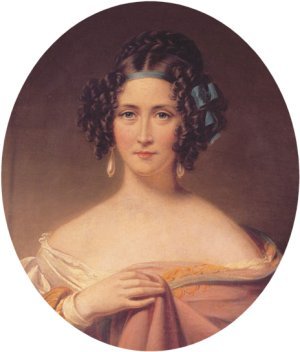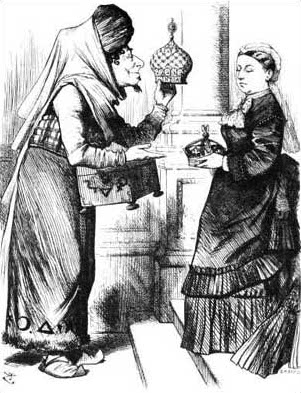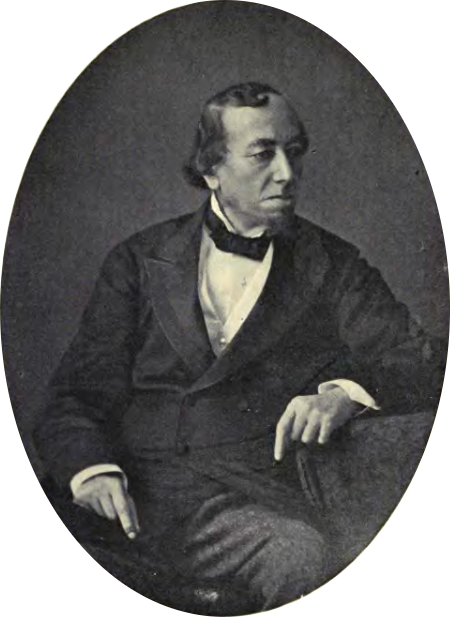by Susan Flantzer
© Unofficial Royalty 2018

Credit – Wikipedia
Born on December 21, 1804 in Bloomsbury, London, England, Benjamin Disraeli, 1st Earl of Beaconsfield, was Prime Minister of the United Kingdom twice during the reign of Queen Victoria, from February 1868 – December 1868 and from 1874 – 1880. Disraeli was the eldest son and the second of the five children of Isaac D’Israeli, a literary critic and historian, and Maria (Miriam) Basevi. All of Disraeli’s grandparents and great-grandparents were born in Italy and were from a Sephardic Jewish background. His paternal grandfather, Benjamin D’Israeli was a Jewish merchant who had emigrated from Cento, Italy in 1748.
Disraeli had five siblings:
- Sarah D’Israeli (1802–1859)
- Naphtali D’Israeli (born and died 1807), died in infancy
- Raphael D’Israeli (“Ralph”; 1809–1898), known as Ralph Disraeli, held the office of Deputy Clerk of the Parliaments, married and had one son and one daughter
- Jacobus D’Israeli (1813–1868), known as James Disraeli, married Isabella Anne Cave, no surviving children
When Disraeli was about six-years-old, he began to attend a dame school, a private elementary school with a woman teacher often located in the teacher’s home. About two years later, he became a boarder at Rev. John Potticary’s St Piran’s School in Blackheath, London. Disraeli was originally raised in the Jewish faith but in 1816, his father had a dispute with his synagogue, renounced Judaism, and had his four children christened in the Church of England.
This change of religion allowed an older Disraeli to think about a career in politics. Until 1858, Members of Parliament were required to take an oath of allegiance containing these words: “…and I make this Declaration upon the true Faith of a Christian…” The Jews Relief Act 1858 allowed any person professing the Jewish religion to omit those words when taking the oath of allegiance.
In 1817, Disraeli began to attend a school run by run by Eliezer Cogan, a minister and a scholar, in Higham Hill, Walthamstow, near London. He was unhappy at the school and had wanted to attend Winchester College, one of the most prestigious schools in England, attended by many future politicians and where his two younger brothers were sent.
Benjamin Disraeli, Earl of Beaconsfield after Sir Francis Grant mezzotint, (circa 1830-1850) NPG D18883 © National Portrait Gallery, London
In 1821, Disraeli was employed as a clerk at a law firm and began to study law. In 1827, he began writing the first of his seventeen novels. He continued writing novels the rest of his life and when he died, he left an unfinished novel. With the money earned from his first novel, he traveled in Europe. Between 1832 and 1835, Disraeli unsuccessfully ran several times for a seat in the House of Commons. Finally, in 1837, the year of Queen Victoria’s accession to the throne, he won a seat as a Conservative Member of Parliament. After having a rough start, Disraeli became a loyal supporter of the party leader Sir Robert Peel and his policies.

Mary Anne Lewis by James Godsell Middleton, circa 1820 – 1830; Credit – Wikipedia
On August 28, 1839, at St. George’s Church, in Hanover Square in London, England, Disraeli married Mary Anne Lewis, the widow of Wyndham Lewis, a Member of Parliament and a close associate of Disraeli. Mary Anne was twelve years older than Disraeli and had a substantial income of £5,000 a year. It is thought that Disraeli married her for her money but the couple learned to love each other. They had no children.
When Sir Robert Peel became Prime Minister in 1841, Disraeli hoped for a Cabinet position but did not receive one and he gradually became a critic of Peel’s government. The Great Irish Potato Famine had caused a disastrous fall in food supplies and so Peel decided to join with Whigs and Radicals to repeal the Corn Laws which imposed tariffs and other trade restrictions on imported food and grain. Peel’s Conservative Party failed to support the bill but it passed with support from other parties and the Duke of Wellington persuaded the House of Lords to pass it. Following the repeal of the Corn Law, Peel resigned as Prime Minister on June 29, 1846.
When the Conservative Party came back in power in 1852 with Edward Smith-Stanley, 14th Earl of Derby as Prime Minister, Disraeli finally got a Cabinet position. He served in the Cabinet as Chancellor of the Exchequer in 1852, 1858 – 1859 and 1866 – 1868. In 1868, Lord Derby died in office and Disraeli succeed him as Prime Minister. In the 1869 elections, the Liberal Party won a majority and William Ewart Gladstone became Prime Minister. Disraeli served as Leader of the Opposition during two of Gladstone’s terms: 1868 – 1874 and from 1880 until his death in 1881.

Disraeli in the 1860s; Credit – Wikipedia
Disraeli served one more term as Prime Minister, from 1874 – 1880. Queen Victoria originally disliked Disraeli due to his treatment of Sir Robert Peel, her second Prime Minister. However, over time she grew to like Disraeli because he took great pains to treat her with flattery. One of his famous quotes was, “Everybody likes flattery and, when you come to royalty, you should lay it on with a trowel.” One thing Queen Victoria wanted was an imperial title. She was disturbed because Alexander II, Emperor of All Russia held a higher rank than her, and was appalled that her eldest daughter Victoria who was married to the Crown Prince of Prussia and the future German Emperor, would outrank her when her husband came to the throne.

A cartoon from the magazine Punch, New Crowns for Old, depicts Disraeli as Abanazer from the pantomime Aladdin, offering Victoria an imperial crown in exchange for a royal one; Credit – Wikipedia
Queen Victoria pressured Disraeli to introduce a bill that would make her Empress of India. Disraeli did so but his handling of the bill was awkward. He did not notify either the Prince of Wales or the Liberal opposition. When they found out, the Prince of Wales was irritated and the Liberals went into motion with a full-scale attack. Disraeli was reluctant to bring the bill to a vote because he thought it would be defeated. However, it passed with a majority of 75. For the rest of her life, Victoria signed her name “Victoria R & I” – Regina et Imperatrix in Latin, Queen and Empress in English. For Disraeli, the unpopular Royal Titles Act undermined his authority in the House of Commons. Four of Victoria’s successors, her son Edward VII, her grandson George V and her great-grandsons Edward VIII and George VI also were Emperors of India. George VI ceased to use the title when India became an independent country in 1947.
In 1868, at the end of Disraeli’s first term as Prime Minister, Queen Victoria wanted to create Disraeli a peer in recognition of his services to the country. If he were a peer, Disraeli would have to leave the House of Commons for the House of Lords, and he did not want to do so at that time. Instead, Disraeli’s wife Mary Anne was created Viscountess Beaconsfield in her own right, allowing her husband to remain a member of the House of Commons. When Disraeli finally agreed to accept the Earl of Beaconsfield peerage in 1876, he automatically lost his seat in the House of Commons but remained Prime Minister, leading his government from the House of Lords. In 1878, Disraeli refused Queen Victoria’s offer to make him a duke, instead, accepting a knighthood in the Order of the Garter.

Disraeli in 1878; Credit – Wikipedia
In 1880, Disraeli called for new elections but his party, the Conservatives, lost and Gladstone was again Prime Minister. Queen Victoria, who detested Gladstone, was very bitter about the election results. Despite being 76 years old and ill with gout and asthma, Disraeli continued serving as the Conservative Party Leader and the Leader of the Opposition. In March 1881, Disraeli became ill with bronchitis. Queen Victoria wanted to visit him but Disraeli declined saying, “She would only ask me to take a message to Albert.” On April 19, 1881, Benjamin Disraeli, 1st Earl of Beaconsfield died at his home 19 Curzon Street in London, at the age of 76.
Disraeli was buried with his wife, who had died in 1872, in the family vault which is located in the west wall of St. Michael and All Angels Church on the grounds of Hughenden Manor, his country home in High Wycombe, Buckinghamshire, England. Queen Victoria also erected a memorial in the chancel of the church. Disraeli also has a memorial in Westminster Abbey which was erected at the instigation of Gladstone who recommended it in his eulogy before the House of Commons.

The grave of Benjamin Disraeli and his wife Mary Anne with primroses growing; Credit – Par Rob Farrow, CC BY-SA 2.0, https://commons.wikimedia.org/w/index.php?curid=9274309

Queen Victoria’s memorial to Disraeli inside At. Michael and All Angels Church; Credit – Von Hans A. Rosbach – Eigenes Werk, CC BY-SA 3.0, https://commons.wikimedia.org/w/index.php?curid=4669256
Until World War I, Primrose Day was celebrated annually on the anniversary of Disraeli’s death. On this day, Disraeli’s tomb and his statue in Parliament Square in London were decorated with primroses. Primroses were his favorite flower and Queen Victoria would often send him bunches of them from Windsor Castle and Osborne House and she sent a wreath of primroses to his funeral.
‘Primrose Day’ (Benjamin Disraeli, Earl of Beaconsfield) by W. Saull wood engraving, 1886 NPG D21540 © National Portrait Gallery, London
This article is the intellectual property of Unofficial Royalty and is NOT TO BE COPIED, EDITED, OR POSTED IN ANY FORM ON ANOTHER WEBSITE under any circumstances. It is permissible to use a link that directs to Unofficial Royalty.
Works Cited
- Baird, Julia. Victoria The Queen. Random House, 2016.
- De.wikipedia.org. (2018). Benjamin Disraeli. [online] Available at: https://de.wikipedia.org/wiki/Benjamin_Disraeli [Accessed 30 Jul. 2018].
- En.wikipedia.org. (2018). Benjamin Disraeli. [online] Available at: https://en.wikipedia.org/wiki/Benjamin_Disraeli [Accessed 30 Jul. 2018].
- En.wikipedia.org. (2018). Mary Anne Disraeli. [online] Available at: https://en.wikipedia.org/wiki/Mary_Anne_Disraeli [Accessed 30 Jul. 2018].
- En.wikipedia.org. (2018). Primrose Day. [online] Available at: https://en.wikipedia.org/wiki/Primrose_Day [Accessed 30 Jul. 2018].
- Fr.wikipedia.org. (2018). Benjamin Disraeli. [online] Available at: https://fr.wikipedia.org/wiki/Benjamin_Disraeli [Accessed 30 Jul. 2018].
- Erickson, Carolly. Her Little Majesty: The Life of Queen Victoria.Simon and Schuster, 1997.
- Hubbard, Kate. Serving Victoria: Life In The Royal Household. Harper Collins Publishers, 2012
